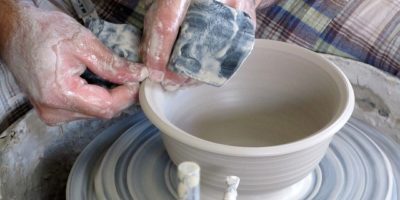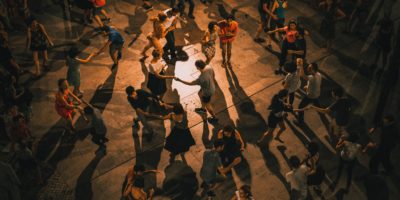Top 10 fun facts about Blaise Pascal
If you’re anything like me, you probably don’t find mathematics very interesting. What can I say? I’m definitely more of a reading and writing kind of gal!
Well, I’m about to blow all of you math-hater’s minds! I’d like to introduce, Blaise Pascal, a French mathematician. Pascal is responsible for some really important inventions, wrote many texts on mathematics and religion, and he was also a child prodigy. Not only that, he achieved these amazing feats in a very short time period, as he died at the young age of 39.
The top 10 fun facts about Blaise Pascal coming right up!
1. Blaise Pascal was a child prodigy

Pascal’s childhood home in Clermont-Ferrand from the book Auvergne historique et artistique – WikiCommons
Blaise Pascal was born in Clermont-Ferrand, France, in 1623. He lost his mother when he was just 3 years old, and was subsequently raised by his father, Étienne Pascal. Étienne was also interested in math and science, and so Pascal was exposed to these fields from a young age.
When Pascal was 5 years old, his family (consisting of his father and his 2 sisters) moved to Paris. Although they had a maid to help around the house, Étienne decided that he would educate his children on his own. He soon realized that all of his children were very intelligent, especially his son.
Pascal showed a really impressive propensity for math and science in particular. When he was 16 years old, he wrote a treatise on something called the “Mystic Hexagram.” This treatise is still known today as Pascal’s theorem!
2. Blaise Pascal almost died as a child
When Pascal was only 1 year old, he suddenly became very ill with an unknown disease. His stomach swelled up, and he became prone to violent fits in which he would thrash around in his bed.
At the time, friends and family assumed it was due to witchcraft! Welcome to the 17th century, ladies and gentlemen, when all unknown diseases were chalked up to witches and sorcerers.
Neighbors blamed an elderly woman that had been caring for Pascal. At first, his father pushed aside the rumors, but when Pascal showed no signs of recovery, he also began to blame the old woman. Under pressure, she admitted to casting a spell on poor little Pascal.
According to the woman, the only way to cure Pascal was to “transfer” the spell onto something else. They applied special herbs to Pascal’s stomach, and brought in 2 stray cats. The, the cats were thrown out of a window to their death. Mysteriously, Pascal began to feel better within a week. Those poor cats!
3. Pascal’s theorem is named after Blaise Pascal
Pascal’s theorem is a theorem in projective geometry. If you’re not a geometry aficionado, it’s a little bit complicated to explain. But, if you’re interested, it states that “if a hexagon is inscribed in a conic, then the three points at which the pairs of opposite sides meet, lie on a straight line.”
Are you confused? Me too. But, this was groundbreaking stuff when Pascal came up with it. Plus, he was just 16 years old when he came to his conclusions! This was so shocking that when Pascal sent his theorem to the famous French mathematician Descartes, he thought that his father had written it.
Pascal was clearly a precocious and intelligent young person. This was just the beginning of his impressive career!
4. Blaise Pascal is one of the inventors of the original mechanical calculator

Pascal’s calculator, also called the Pascaline, as seen at the Arts et Métiers museum in Paris – WikiCommons
I think that today we take calculators for granted. Whenever we need help with math, we can easily pull out our smartphones and plug in a few numbers, easy peasy. That wasn’t the case in the 17th century. Until Pascal came along!
When Pascal’s father was working as a tax supervisor in Rouen, the young mathematician saw a need for a machine that would help with all of the tiresome calculations. There had to be an easier way! And so started Pascal’s 3 year project to create a mechanical calculator.
Pascal designed the original machine in 1642, when he was 19 years old. He went on to create 50 prototypes before he presented his findings in 1645. He then went on to produce 20 more models over the next 10 years, when finally he was granted a “royal privilege” by King Louis XIV. A royal privilege is similar to a patent, and the calculator’s were called Pascal’s calculator from there on out.
You can see an example of Pascal’s calculator (also called a Pascaline) at the Arts et Métiers museum in Paris!
Practical information for visited the Arts et Métiers museum in Paris:
Entry fee: 8 euros
Opening hours: Tuesday-Sunday 10am-6pm, Thursday until 9:30pm, closed Monday
Address: 60 Rue Réaumur, 75003 Paris
Metro station: Arts et Métiers
Website
5. Blaise Pascal contributed much to the study of geometry
Oh, geometry. Also known as, my worse subject in school. I nearly failed my year of geometry, but my teacher ended up passing me because she saw how much effort I was putting into the course…in vain! Like I said, I’m definitely more of a literature person.
This wasn’t the case for Pascal, of course! Over his lifetime, he contributed much to the “philosophy of mathematics,” which is a branch of philosophy that studies, you guessed it, the principles of math.
His major contribution was a work of writing called De l’Esprit géométrique (Of the Geometrical Spirit in English). Inside, Pascal discussing the question of discovering truths in geometry.
He also developed a theory of definition in Of the Geometrical Spirit. Pascal discerned the difference between definitions that are used and defined by writers, and definitions that occur within languages as a whole and which are innately understood by native speakers.
6. Blaise Pascal invented the syringe
In addition to his contributions to the field of mathematics, Pascal also contributed much to the field of hydrodynamics and hydrostatics, which were based on his findings on the principles of hydraulic fluids.
One important invention that came out of his work with hydraulic fluids is the syringe! He was able to create this valuable innovation thanks to what is known today as Pascal’s Law.
Pascal’s Law states that “a pressure change at any point in a confined incompressible fluid is transmitted throughout the fluid such that the same change occurs everywhere.” This idea makes a syringe possible!
7. Blaise Pascal was very religious
In 1646, Pascal slipped and fell, breaking his hip. This near-death experience profoundly changed the mathematician, and he subsequently became very religious.
Pascal was a follower of Jansenism, a branch of Catholicism. Jansenists believe that salvation could only be achieved by the grace of God, not through moral acts. Scholars usually refer to this as Pascal’s “first conversion.” He began to write theological texts soon after.
His “second conversion” occurred in 1654. According to Pascal, he had a religious vision. He wrote down what he experienced, describing it as such, “Fire. God of Abraham, God of Isaac, God of Jacob, not of the philosophers and the scholars…” Eerie!
Today, this slip of paper is referred to as the Memorial. Pascal sewed the note into his clothing and had it on his person at all times. We know this because the piece of paper was found by one of his servants at the time of his death.
After his second conversion, Pascal stopped working in the field of mathematics completely.
8. Blaise Pascal wrote many important theological works

The original manuscript of Thoughts by Blaise Pascal as seen at the Bibliothèque nationale de France in Paris by ActuaLitté on Flickr
The most important theological texts that Pascal wrote are Lettres provincials (Provincial Letters in English) and Pensées (Thoughts in English).
Pascal published Provincial Letters under the pseudonym Louis de Montalte. Inside, he attacked many Catholics for something called “casuistry,” which is a school of thought that tries to justify immorality and sinning. The text was so scathing, that King Louis XIV ordered the book to be shredded.
Thoughts spoke on and defended the Christian faith, and is considered to be Pascal’s most influential theological work. It was incomplete at the time of his death, and was published posthumously. It is also considered to be a landmark in the world of French prose.
9. Blaise Pascal invented the first form of modern public transportation in Paris

Commemorative plaque for the 350th anniversary of the launch of the carrosses à cinq sols in Paris. The plaque is located in Clermont-Ferrand, the birthplace of Blaise Pascal – WikiCommons
One of Pascal’s last major accomplishments was the first form of public transportation in Paris. It was called the carrosses à cinq sols, and can be compared to a modern bus system!
In the late 17th century, Paris boasted 500,000 residents, 500 major roads and nine bridges. With all of those residents and streets, a form of shared public transportation became necessary.
That’s where Pascal came in. He created a system of large horse drawn carriages. This involved a large carriage pulled by 4 horses, a valet and a driver. The carriages were able to house 8 passengers and followed specific routes. The carriages stopped when the passengers requested, or when there were passengers waiting at distinct stops. Sounds just like a bus, right?
10. Blaise Pascal died at the young age of 39
Pascal suffered from frail health his entire life. He often had headaches and stomachaches. After the death of one of his sisters, his health began to severely decline, rendering him bedridden.
Pascal knew that he was dying, and so he requested to be moved to a hospital to live out his final days. But, he was so sick that he couldn’t be moved. He died in 1662.
After his death, an autopsy was performed on his body which showed signs of tuberculosis, stomach cancer and many other maladies. The autopsy also showed that he may have had brain cancer as well, which would explain his severe headaches.
Pascal is buried in the Saint-Étienne-du-Mont cemetery in Paris. His body has since been moved inside the church along with French playwright Jean Racine.
Practical Information for visiting Saint-Étienne-du-Mont in Paris:
Entry fee: free
Opening hours: Tuesday-Friday 8am-7:45pm, Saturday: 8:45am-12pm, 2pm-7:45pm, Sunday: 8:45am-12:15pm, 2pm-7:45pm
Address: Place Sainte-Geneviève, 75005 Paris
Metro station: Cardinal Lemoine
Conclusion
Even if you aren’t an expert mathematician or theologist, Blaise Pascal is definitely worth learning about! He contributed so many important innovations to his fields, and the world wouldn’t be the same without his inventions.
I hope you enjoyed learning more about Mr. Pascal. If you want to learn more about major French personalities, why not join one of our walking tours in Paris? Our local guides are sure to impress you with their vast knowledge, and the tours are really fun, too. Click here to learn more and to sign up for a tour!
Planning a trip to Paris ? Get ready !
These are Amazon’s best-selling travel products that you may need for coming to Paris.
Bookstore
- The best travel book : Rick Steves – Paris 2023 – Learn more here
- Fodor’s Paris 2024 – Learn more here
Travel Gear
- Venture Pal Lightweight Backpack – Learn more here
- Samsonite Winfield 2 28″ Luggage – Learn more here
- Swig Savvy’s Stainless Steel Insulated Water Bottle – Learn more here
Check Amazon’s best-seller list for the most popular travel accessories. We sometimes read this list just to find out what new travel products people are buying.
















